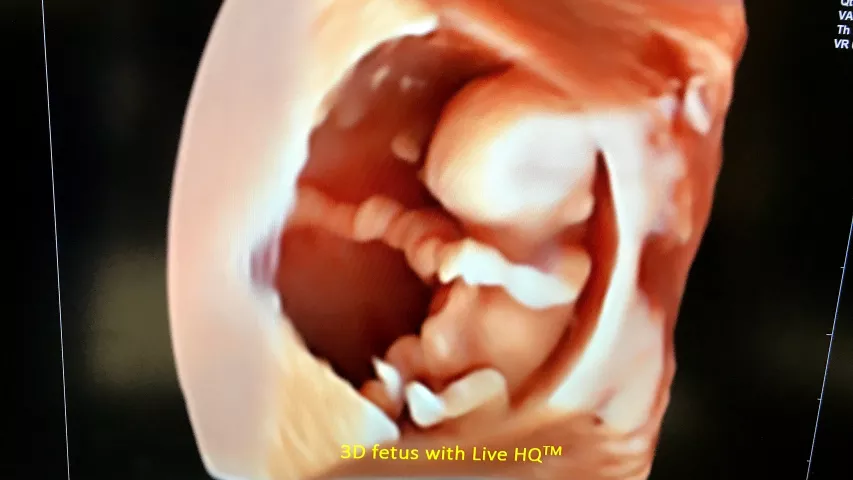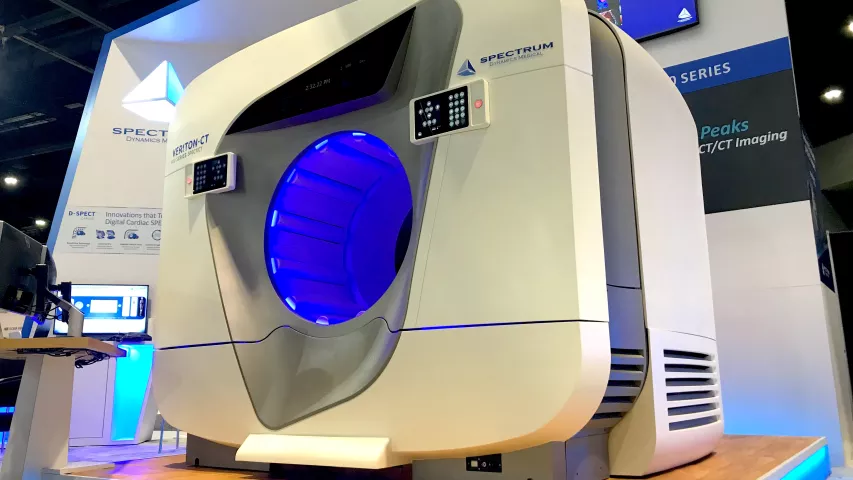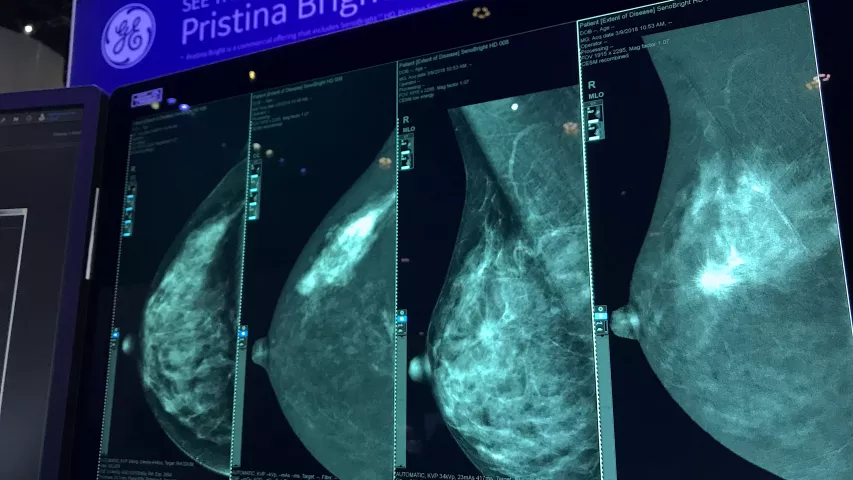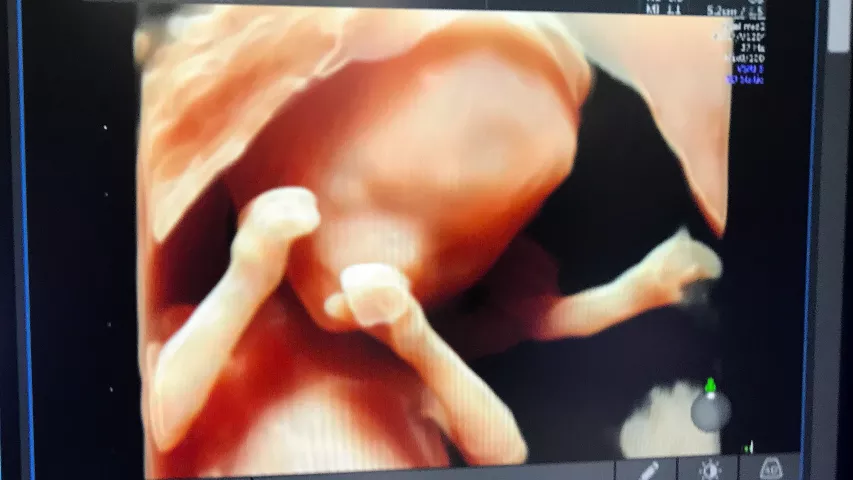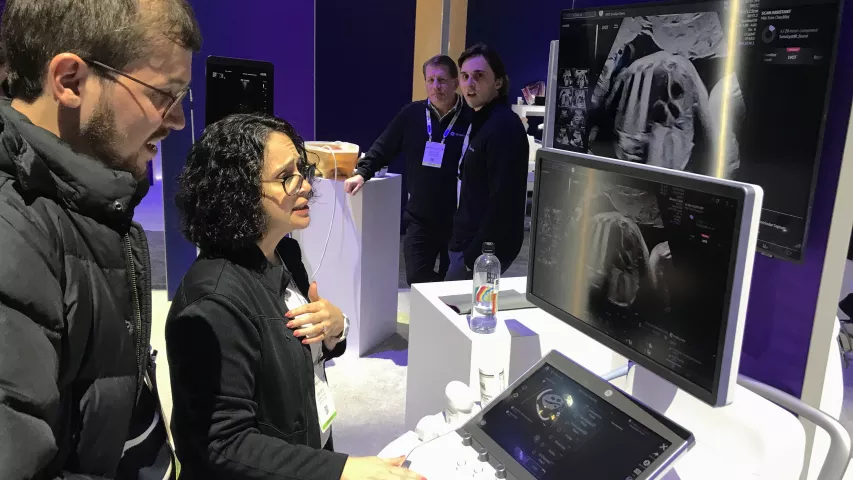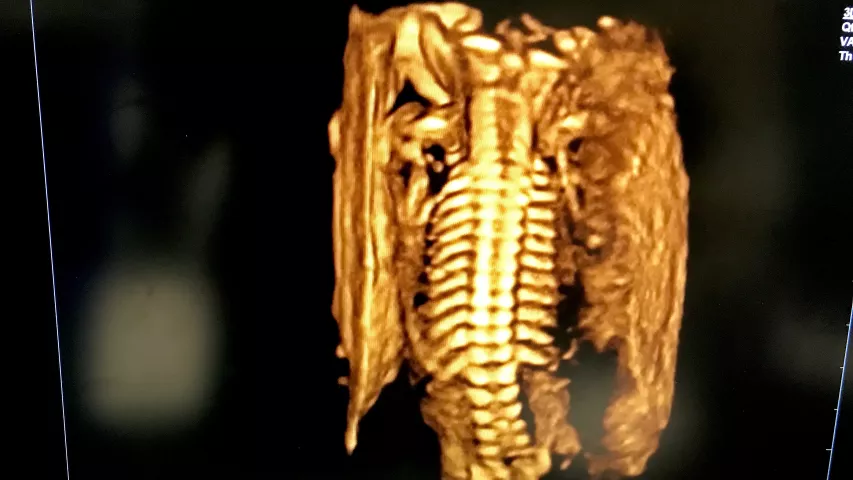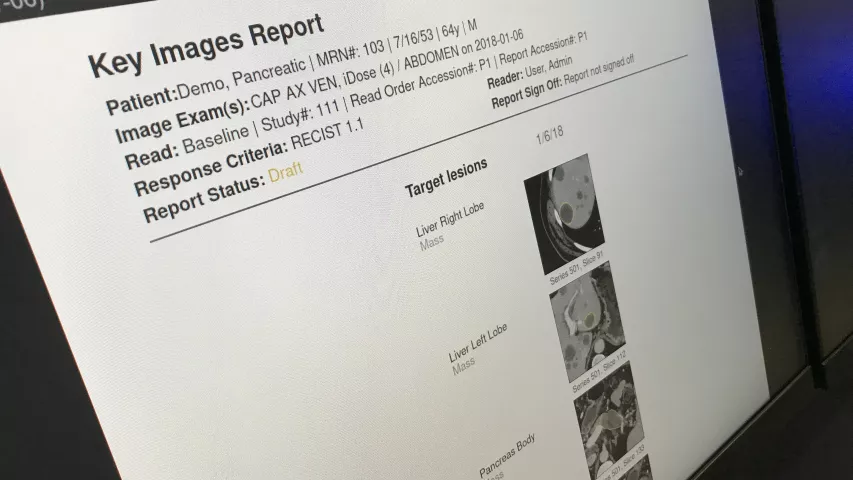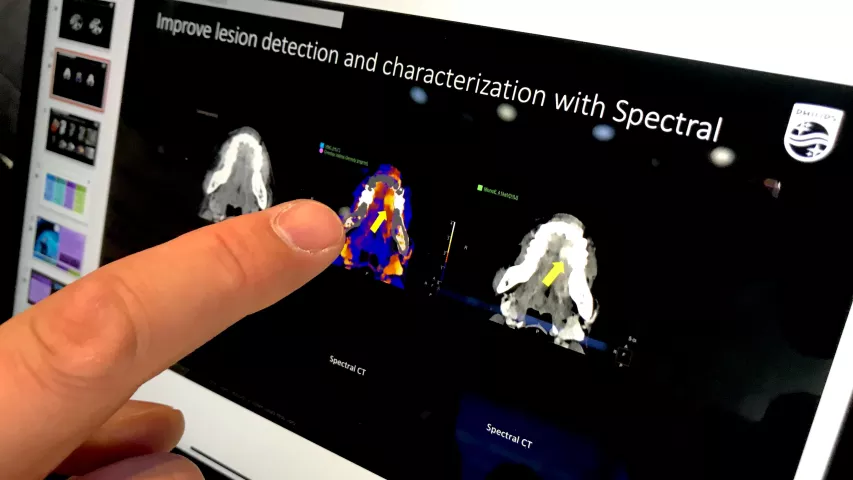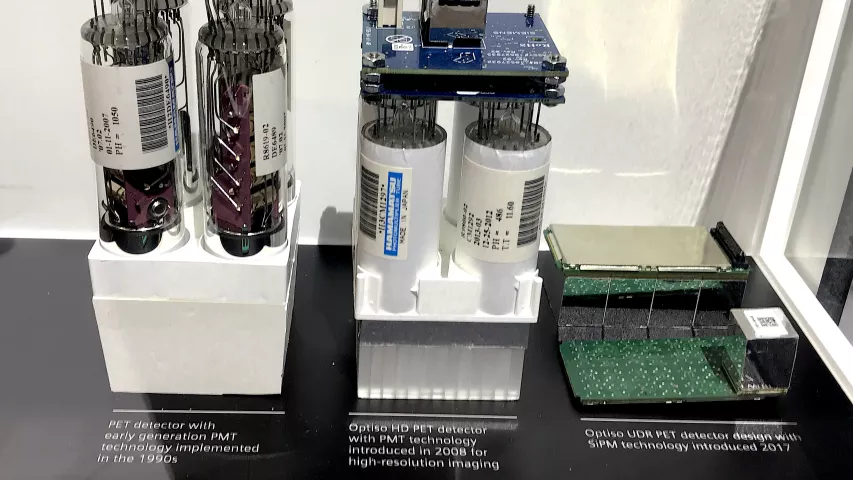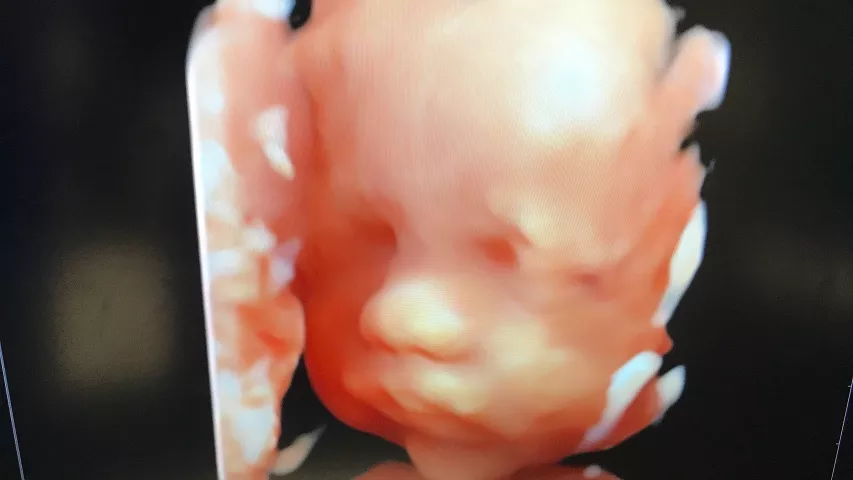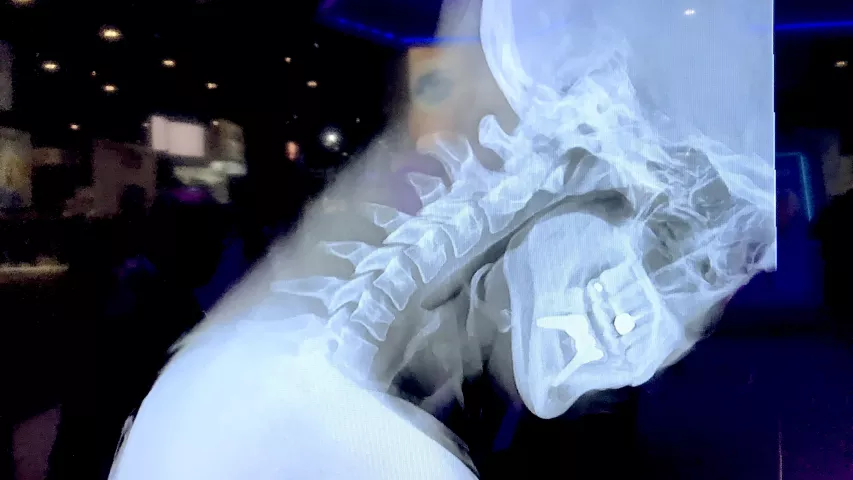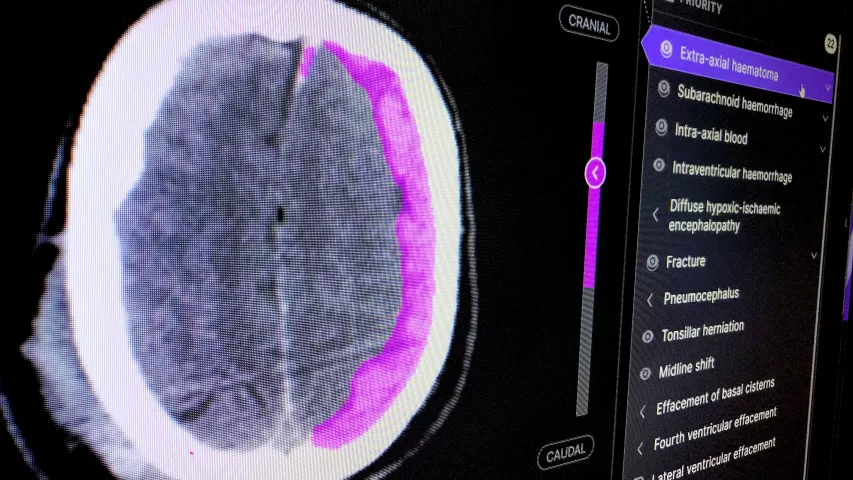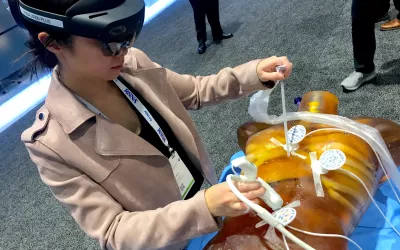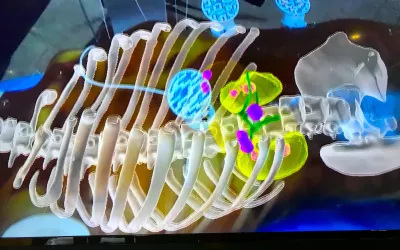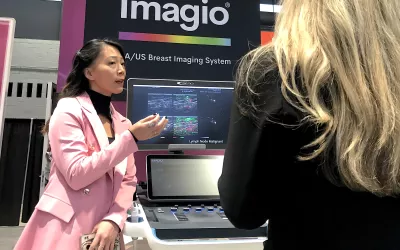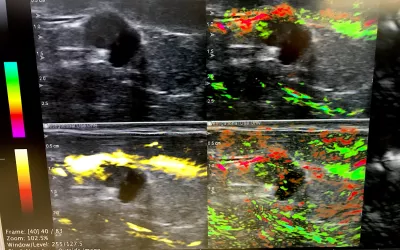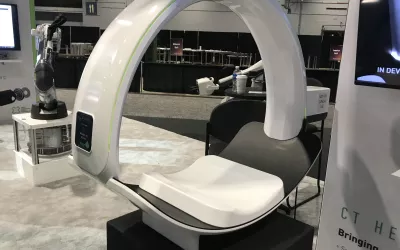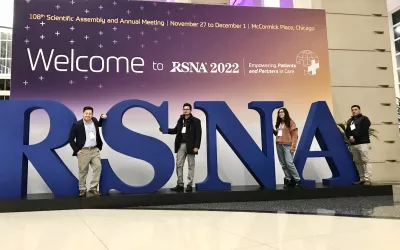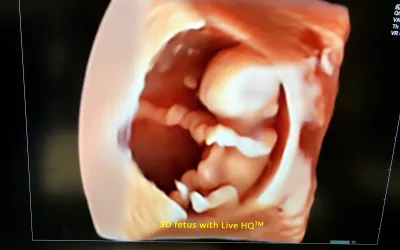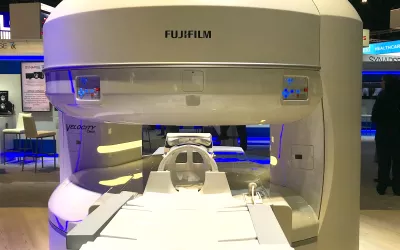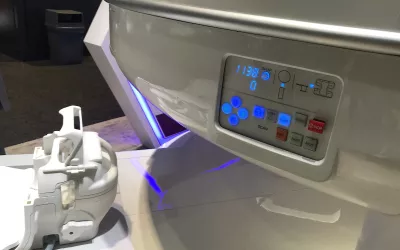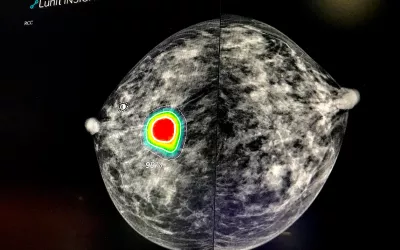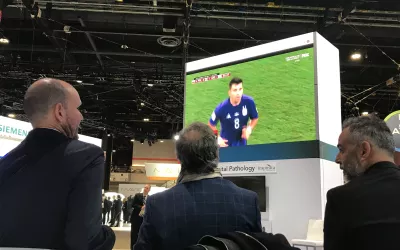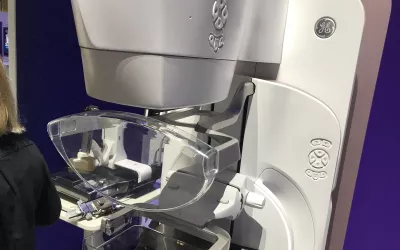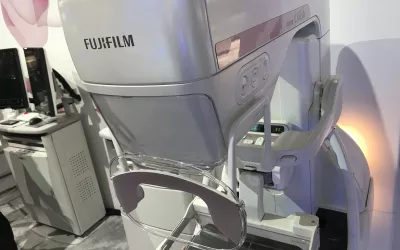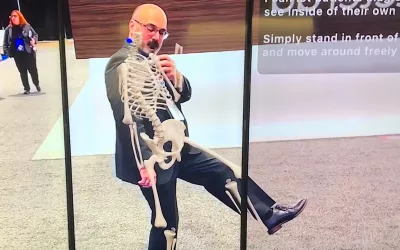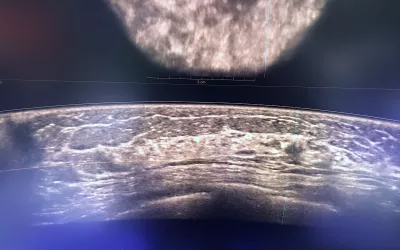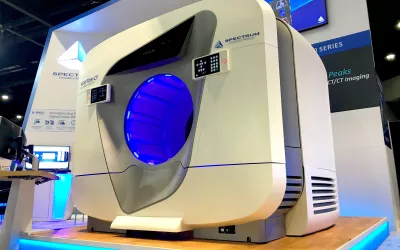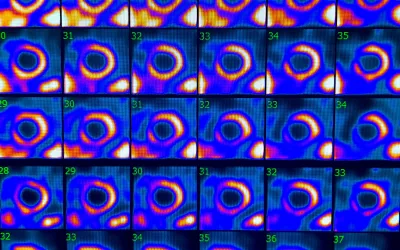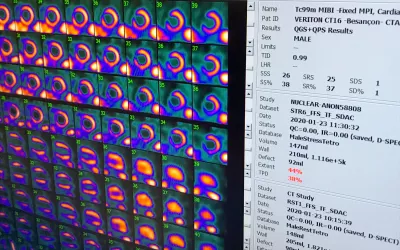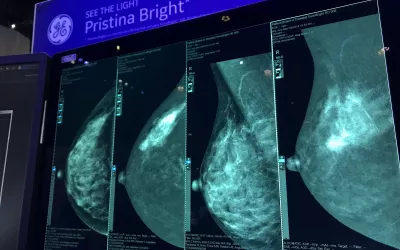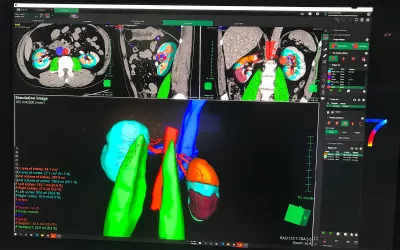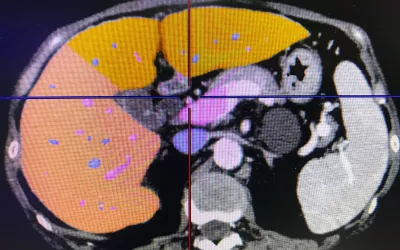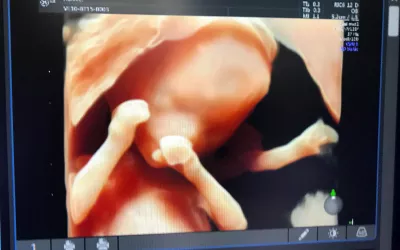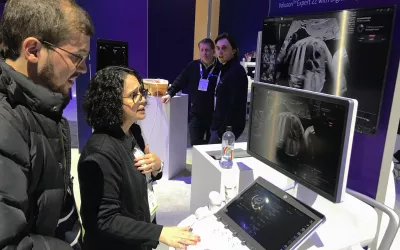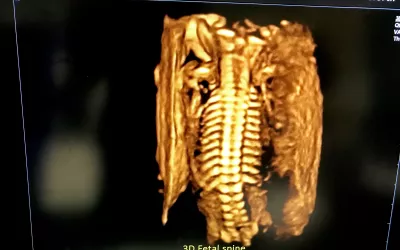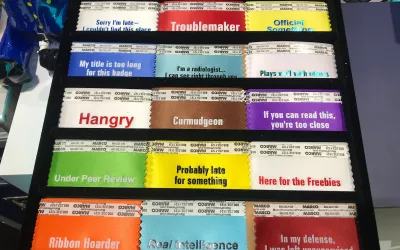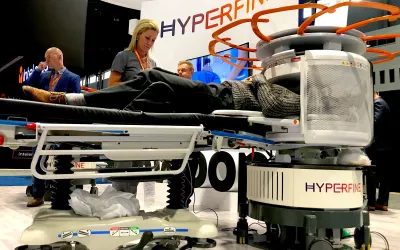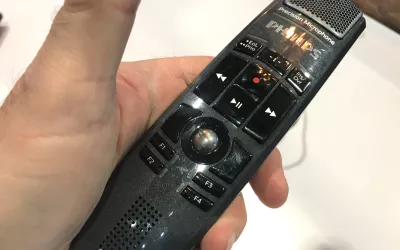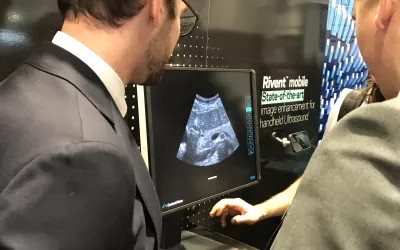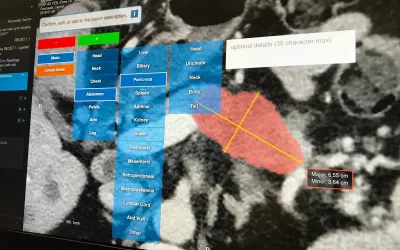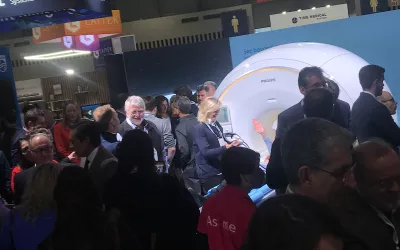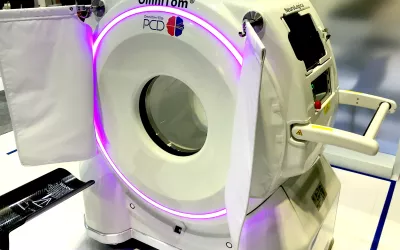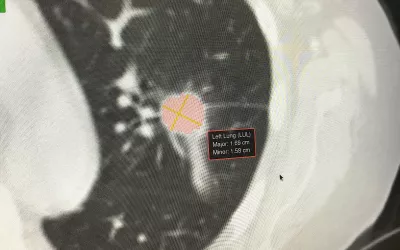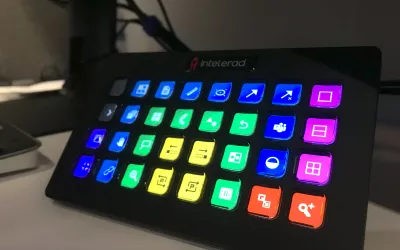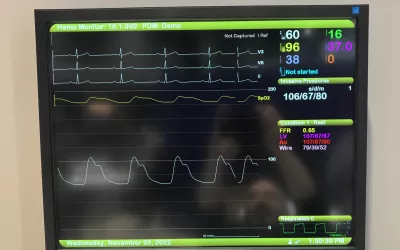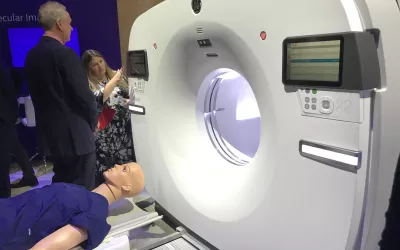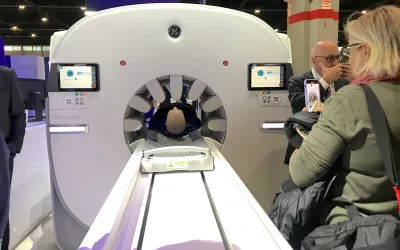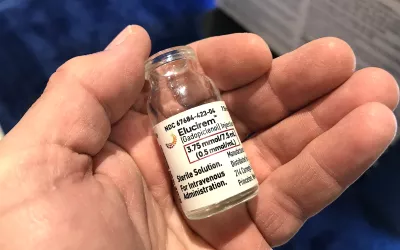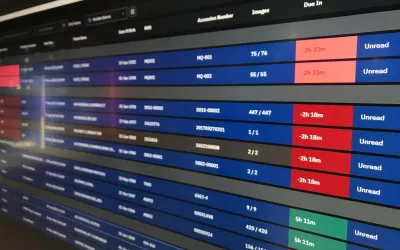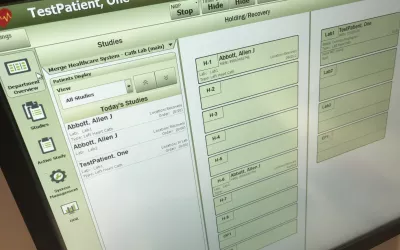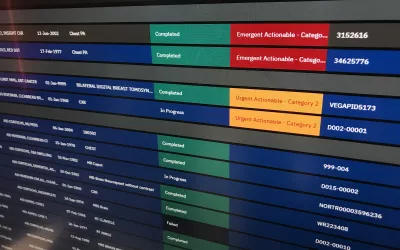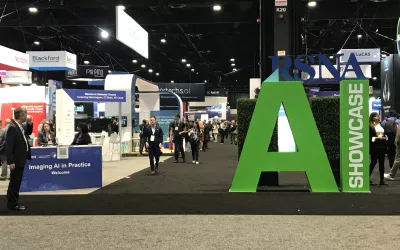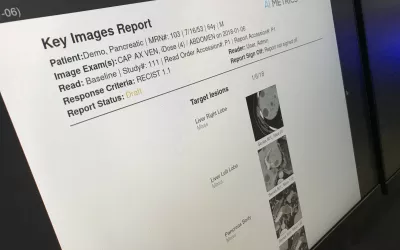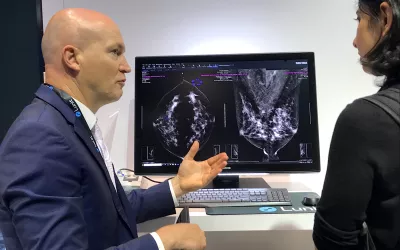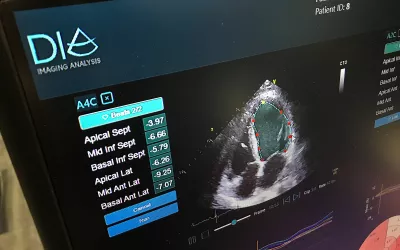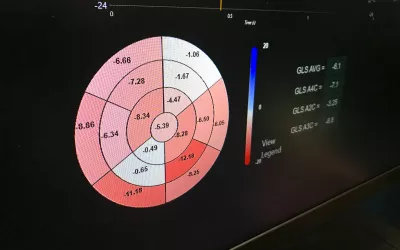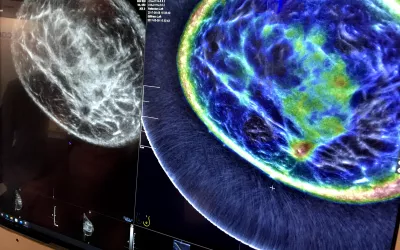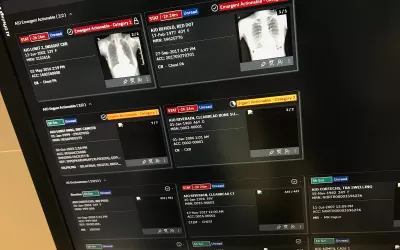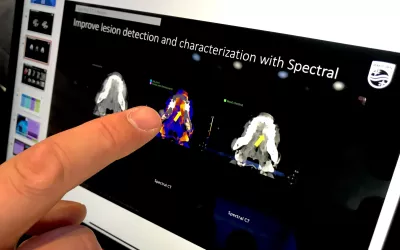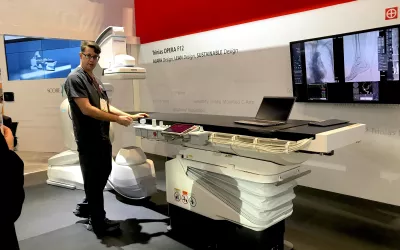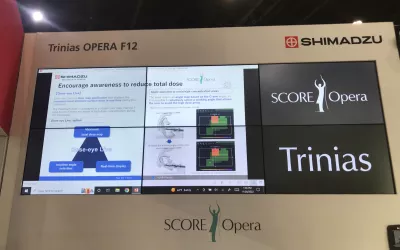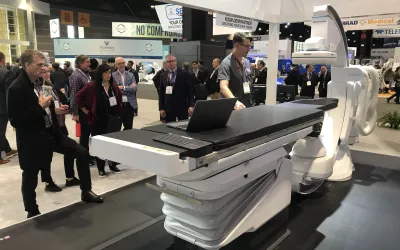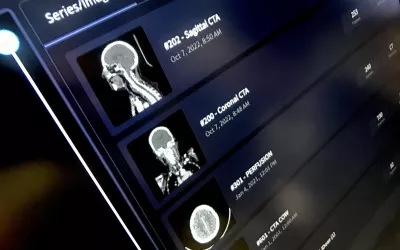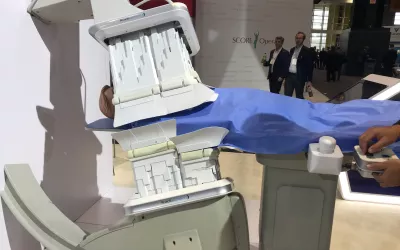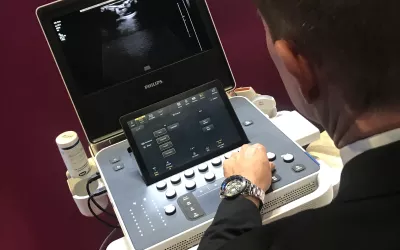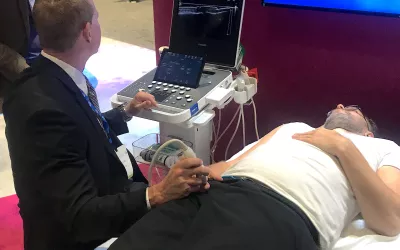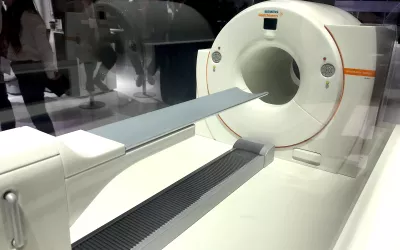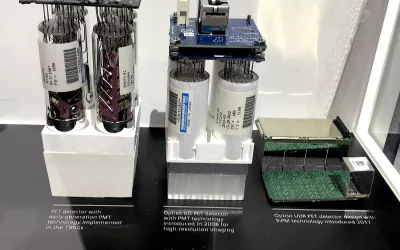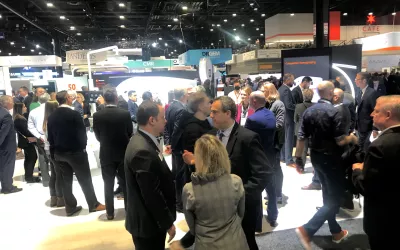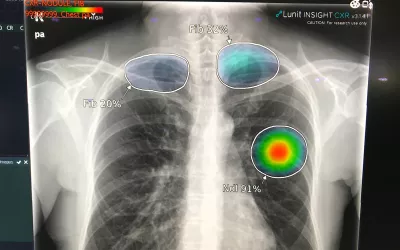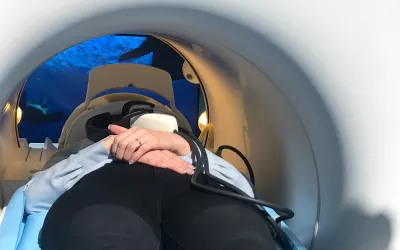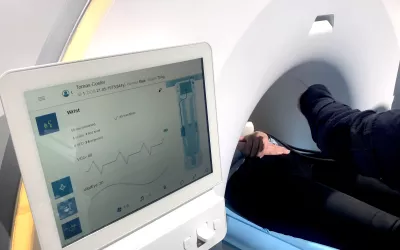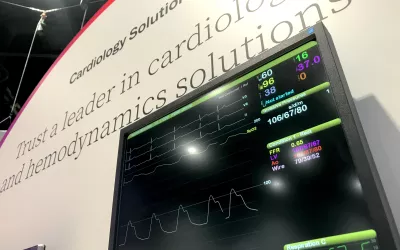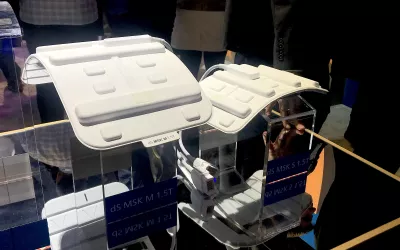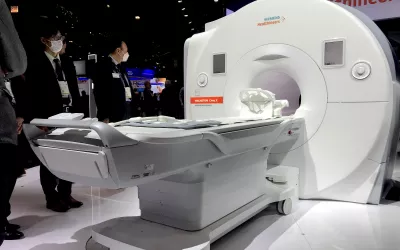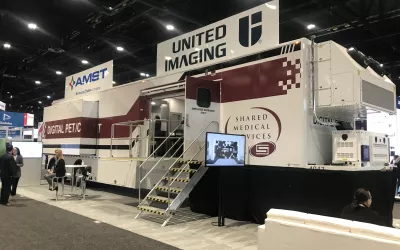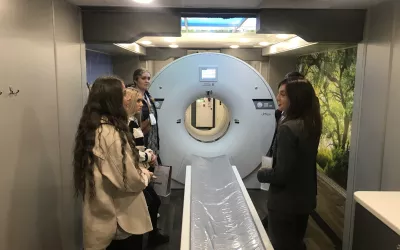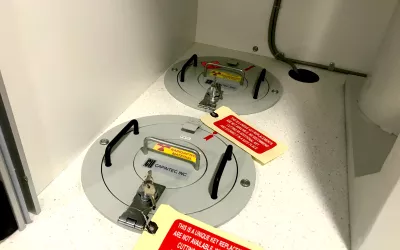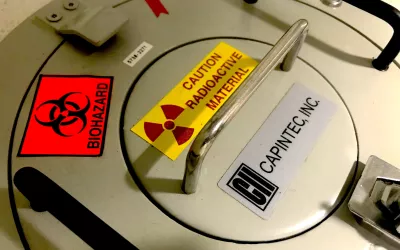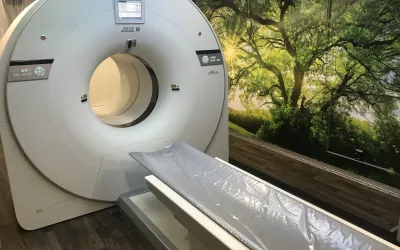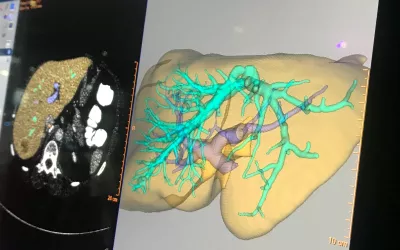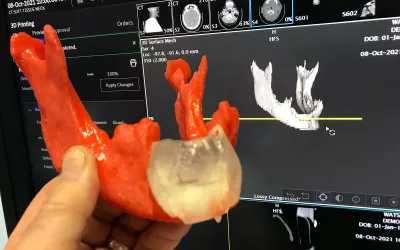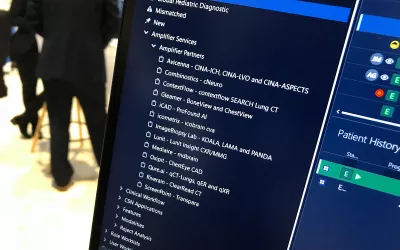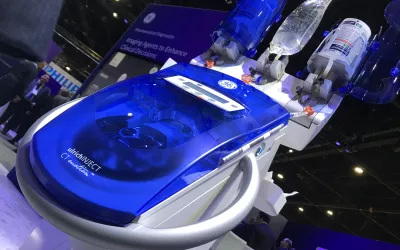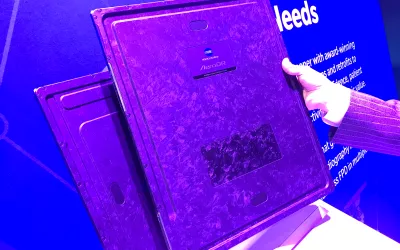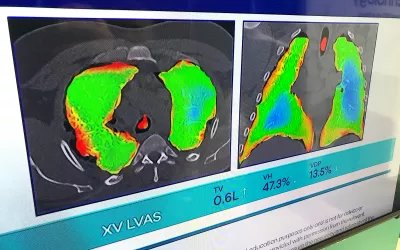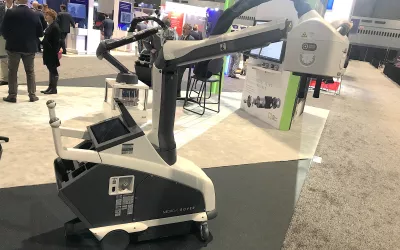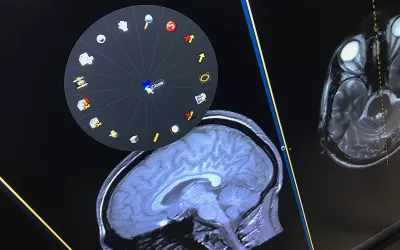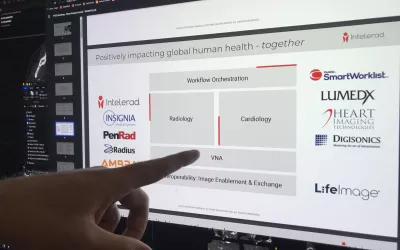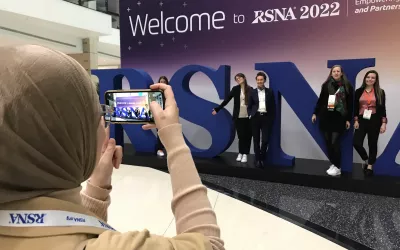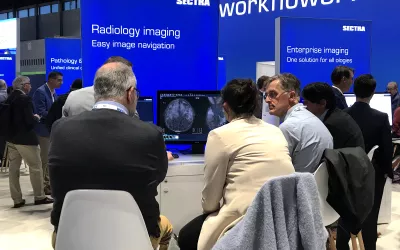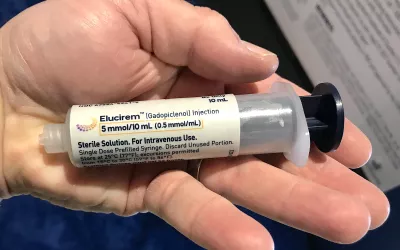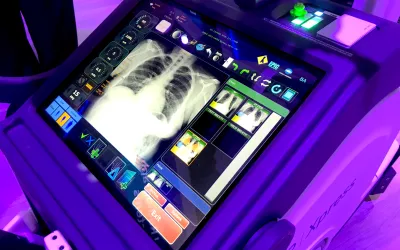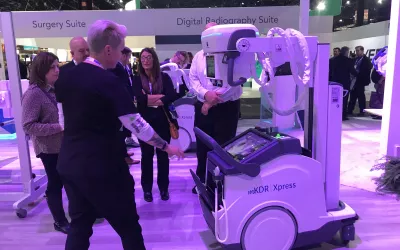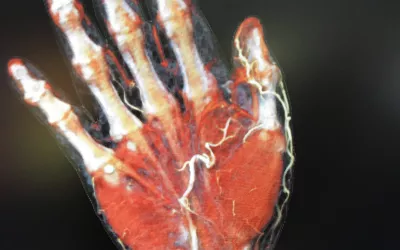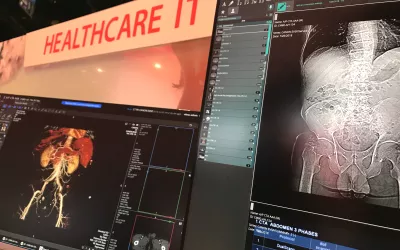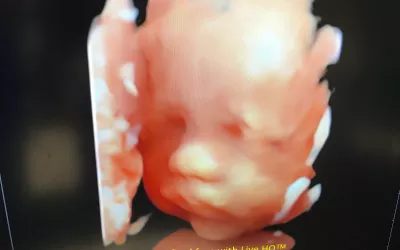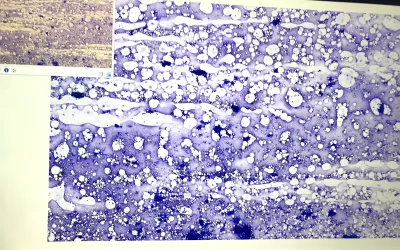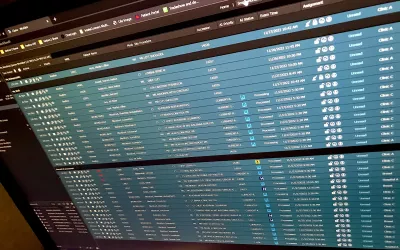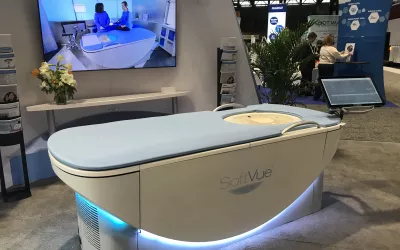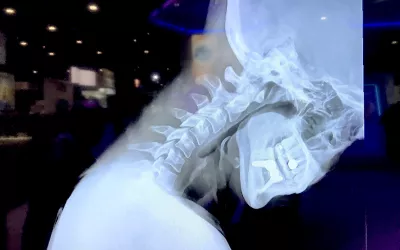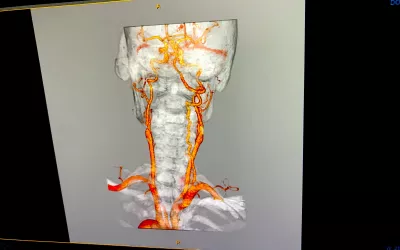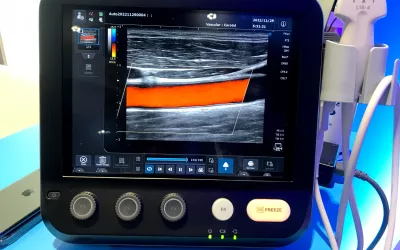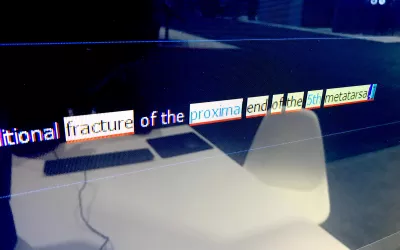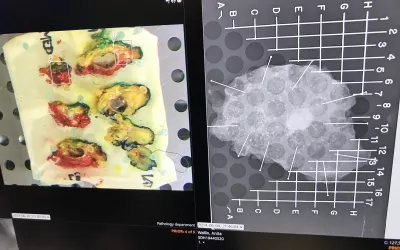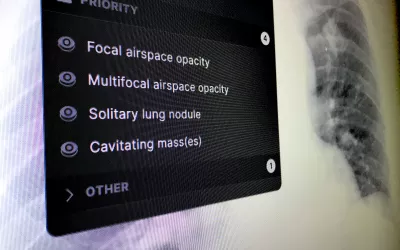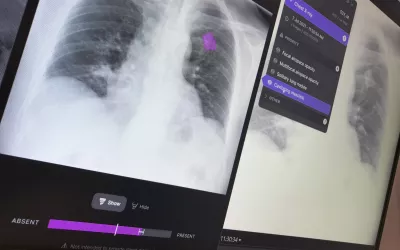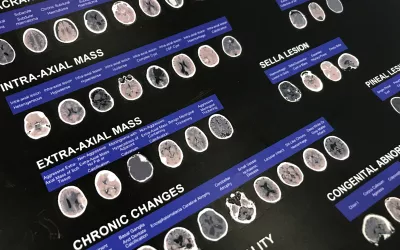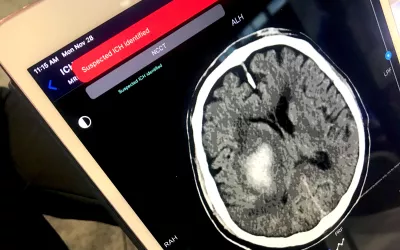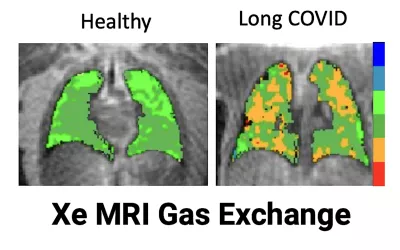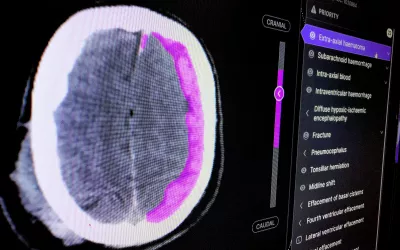PHOTO GALLERY: New technology and trends at RSNA 2022
Images from the Radiological Society of North America (RSNA) 2022 annual meeting Nov. 27- Dec. 1 in Chicago. The gallery includes new technologies and a look at sights around the world's largest radiology conference. Find more news and video on our RSNA page.
The new breast imaging modality of opto-acoustic ultrasound (OA/US) is explained at the Seno Medical booth at RSNA 2022. The technology uses 6 separate images to show the functional and anatomic features of breast tissue and immediately display features that differentiate tumor neo-angiogenesis. This may prevent the need for additional testing or biopsy. The system just received U.S. FDA PMA clearance and the vendor celebrated with champaign being served in their booth.
The new breast imaging modality of opto-acoustic ultrasound (OA/US) from Seno Medical just received U.S. FDA PMA clearance and the vendor celebrated with champaign being served in their booth at RSNA. is explained at the Seno Medical booth at RSNA 2022. The technology uses 6 separate images to show the functional and anatomic features of breast tissue and immediately display features that differentiate tumor neoangiogenesis. This may prevent the need for additional testing or biopsy.
The new breast imaging modality of opto-acoustic ultrasound (OA/US) is explained at the Seno Medical booth at RSNA 2022. The technology uses 6 separate images to show the functional and anatomic features of breast tissue and immediately display features that differentiate tumor neo-angiogenesis. This may prevent the need for additional testing or biopsy. The system just received U.S. FDA PMA clearance and the vendor celebrated with champaign being served in their booth.
This is a cold-cathode tube CT system to image head trauma and the brain shown my Micro-X. The vendor said it is already being deployed in Australia and can be installed in an ambulance for immediate stroke imaging. It uses carbon nanotube cold cathode X-ray technology, which eliminates the need for cooling systems, related structural supports and drive systems, which allows for very small, compact, lightweight and less expensive imaging systems.
Fujifilm employees watching the World Soccer Cup the last day of the RSNA expo when traffic is traditionally slow. Several vendors put the World Cup matches up on their large screens in their booths. When the U.S. played Iran, cheers could be heard across the floor when the U.S. team scored a goal. There is a sizable number of international attendees and and vendors, so there was wide interest in the cup across the event.
The Fujifilm Aspire Cristalle mammography system on display at RSNA 2022. this is a 3D mammography system that enables digital breast tomosynthesis (DBT). Like a CT scan, it creates slices that can be flipped through to see the layers of tissue and better define if an area of suspected cancer is a series of layers of dense breast tissue or an actual lesion.
Example of a skeleton superimposed and fused with a patient so as they move, the bones can be seen moving with them. The MediMirror demonstrated this at RSNA 2022 this week to show how the technology can be used for patient education. They can also fuse CT segmented images such as various organs or a collection of anatomy to show the patient where issues are located and how they can be treated.
Automated breast ultrasound (ABUS) allows for reproducible breast imaging without variation based on which sonographer performs the exam. It also can help centers where they are short on qualified breast sonographers. Breast ultrasound can help identify cancers, or benign cysts, even in women with very dense breast tissue. At the GE Healthcare booth at RSNA.
There has been renewed interest in nuclear imaging at RSNA over the past few years and many vendors showed new technologies. Part of this interest has been spurred because SPECT and PET technologies have advanced and hospitals are now looking to replace older systems from more than a decade ago. This is an example of one of the advanced SPECT-CT systems on the floor, the Spectrum Dynamics Veriton 400. Its digital detector is capable of imaging energies of 400 kev. It is primary aimed at the cardiology market. It has detector arms that come out from the bore to the patients chest to help enhance image quality.
Contrast-enhanced mammography can help confirm a cancer or dismiss a false positive diagnosis while the patient is still at a women’s imaging center. This case displayed by GE shows a clear spiculated cancer mass on the contrast-enhanced images, but dense breast tissue hides the actual extent of the the tumor on the mammogram. Find out more in the VIDEO: Why contrast enhance mammography might be the ideal supplemental imaging - interview with Connie Lehman, MD, at Mass General.
Point-of-care ultrasound (POCUS) image enhancement software shown by ContextVision. The vendor said POCUS use has been limited because many physicians want to do more than just a quick look. This app allows for more diagnostic quality exams comparable to larger, more expensive imaging systems. ContextVision works as a software OEM for several of the big imaging systems vendors.
Pancreas on a CT automatically identified and countered from a CT scan by AI Metrics' cancer RECIST followup technology. The software can help[ call up prior serial exams and speed workflow when reviewing cancer treatment followup exams to see if treatments are affective. The AI can help reduce reproducibility issues between various radiologists.
The second commercially available photon-counting CT system on the RSNA expo floor — the Samsung Omnitom Elite PCD. It gained FDA clearance for the photon-counting detector in early 2022. Several vendors are also working on photo-counting CT systems, and a couple made announcements about advances in their research programs at RSNA. PCDs are widely expected to to become a big technology leap for CT with its ability to improve image resolution, reduce dose and built in spectral imaging for all scans. Read more in 9 technology trends and takeaways from RSNA 2022.
Automated lung cancer detection and contouring by the AI Metrics cancer followup RECIST analysis artificial intelligence. The software is designed to speed serial cancer imaging exams to determine if treatment is working or not. The AI also helps increase consistency in the quantification of the tumor.
A new control box with one-button press access to a variety of radiology PACS functions has been added to increase Intelerad's workflow efficiencies. At least one other vendor of the RSNA floor introduced a similar control box as workflow efficiency has become the key discussion point with PACS and enterprise imaging systems at both HIMSS and RSNA.
Cath lab hemodynamic system waveform and data displayed in the cardiology section of the Merge booth at RSNA 2022. Merge was purchased by IBM Watson with the goal of building a premier healthcare AI company. When that effort failed and IBM sold off its healthcare division recently to be reorganize into the new vendor Metative. However, the Merge name was revived and placed front and center at RSNA this year in banners around the conference because it was a strong company prior to its purchased by IBM. While AI, mainly through partnerships with AI vendors, is part of the new company, there has been a return to the core technologies Merge offers for PACS, enterprise imaging and CVIS.
PET nuclear imaging has seen some recent advances and increasing adoption in the past couple years, and that trend was evident on the RSNA 2022 expo floor with several new systems being displayed. GE Healthcare introduced the Omni Legend at RSNA 2022, an all-digital PET/CT platform. The new digital BGO (dBGO) detector material uses a small crystal size to deliver more than two times the sensitivity of prior digital scanners to enable faster scans and better small lesion detectability.
The new MRI contrast agent gadopiclenol, sold under the trade names Elucirem and Vueway by Bracco and Guerbet, uses 50% less gadolinium than current MRI agents. Read more on this technology.
Example of AI sorting exams in a radiology DICOM worklist to read first based in the AI screening the studies and marking the ones that are not normal and likely to have critical findings at the top of the list for priority reads. Example shown by Merge, but similar technology exists on most PACS vendors software with elements of workflow orchestration.
The Artificial Intelligence Showcase at RSNA included a large number of vendors and covered a quarter of the South Hall's show floor. Read more about the AI advances seen on the show floor.
Strain cardiac echo imaging has become a hot topic in cardiac ultrasound and many cardiologists now see utility with the additional clinical information it can provide to inform care decisions. However, it can be time consuming and many centers have low usage of strain, even if they have strain packages on their systems. Dia showed an automated strain AI application at RSNA this year aimed at automating the process to increase strain usage.
An example of the Delphinus whole breast ultrasound tomography technology. A ring transducer surrounding the breast creates an image of the whole breast, similar to MRI. It also uses reflection, sound speed and attenuation to characterize the tissue structure, as seen in the color-coded image, to help identify cancers.
The Artificial Intelligence Showcase at RSNA included a large number of vendors and covered a quarter of the South Hall's show floor. Read more about the AI advances seen on the show floor.
RSNA attendee tries out the new Philips 5300 MRI system video viewing system (projected on the wall behind the MRI and viewed using a mirror) to entertain patients during longer exams. It is a "helium free" system. It has a sealed cooling system so it only uses 7 liters of helium, as opposed to the usual 1,500 liters in conventional MRI systems.
Cath lab hemodynamic system displayed in the cardiology section of the Merge booth. Merge was purchased by IBM Watson with the goal of building a premier healthcare AI company. When that effort failed and IBM sold off its healthcare division recently to be reorganize into the new vendor Metative. However, the Merge name was revived and placed front and center at RSNA this year in banners around the conference because it was a strong company prior to its purchased by IBM. While AI, mainly through partnerships with AI vendors, is part of the new company, there has been a return to the core technologies Merge offers for PACS, enterprise imaging and CVIS.
Several semi-truck trailer, mobile imaging systems were on display this year at RSNA 2022. This one is has a United Imaging PET-CT nuclear imaging system that can be moved to various hospitals in rural areas to provide access to advanced hybrid imaging, while keeping it cost effective for lower volume hospitals.
Several semi-truck trailer, mobile imaging systems were on display this year at RSNA 2022. This one is has a United Imaging PET-CT nuclear imaging system that can be moved to various hospitals in rural areas to provide access to advanced hybrid imaging, while keeping it cost effective for lower volume hospitals.
Syringeless contrast media injectors like the GE Ulrich CT Motion gained a lot of interest in 2022 because of the iodinated contrast shortage. These systems use rollers to squeeze precise amounts of contrast from a large bolus container for multiple patients, helping conserve a significant amount of contrast.
FDA-cleared, cold-cathode mobile DR X-ray system at RSNA 2022. The Micro-X Rover uses carbon nanotubes rather than the standard filaments used in X-ray tubes for the past century. The nano tubes produce an electron beam in the tube without producing heat, which is the majority of the energy released in standard tubes. This eliminates the need for cooling systems, the related structural metal supports and motorized drive system because of a massive weight reduction. Read more on this technology.
There has been a lot of consolidation and mergers of radiology vendors in the past several years, especially on the health IT side. This is an example from a booth presentation at Intelerad showing a list of the vendors the company has purchased to add additional functionality to its enterprise imaging platform, including large pieces for cardiology, remote viewing, workflow solutions and vendor neutral archive (VNA).
The new MRI contrast agent gadopiclenol, sold under the trade names Elucirem and Vueway by Bracco and Guerbet, uses 50% less gadolinium than current MRI agents. Read more on this technology.
The Delphinus offers whole breast 3D ultrasound tomography system. To use the system, the patient lays in a prone position on a table with their breast inserted into a hole in the table. It is filled with water and a light suction device pulls the breast down to elongate without compression. It has a ring ultrasound transducer to create the tomography images and offers data on tissue composition to help assess cancers. Read more on this technology.
Example of artificial intelligence lung X-ray analysis detecting four different findings and marking them as priority before the exam is seen by a radiologist, who can then confirm the findings. This type of technology can help move studies with suspected findings to the top of worklists. Example shown by Annalise.AI at RSNA 2022.
Many radiologists are still unsure about how much to trust artificial intelligence algorithms in reading exams. In response, some vendors have added confidence level indicators (bar graph under image) to show the level of certainty the AI has in its own finding based on the studies it was trained on. This is an AI lung assessment software from Annalise.AI at RSNA 2022.
Example of the number of AI algorithms available outside the U.S. for brain conditions by the vendor Annalise.AI. The U.S. FDA requires a higher bar for AI clearance, so the vendor is submitting only a fraction of these for review due to the time and costs it would take to clear them all one-by-one. Several vendors said this has been an obstacle to faster and wider AI approvals in the U.S.
Image of xenon gas MRI imaging showing areas where gas exchange in the longs is compromised due to long-COVID lung damage or continued inflammation. This was presented in sessions as a way to track long-COVID and to better evaluate damage in gas exchange membranes in the lungs that may be causing long-COVID symptoms.Find more COVID radiology imaging
Example of an AI finding highlighted by a brain algorithm shown by Annalise.AI at RSNA 2022. The colored areas can show where the AI believes there is an abnormality. The FDA does not like the color coding on AI apps and prefers the AI to just indicate there is an issue on and exam to alert the radiologist to then find the detected problem. Many of the color coded exams seen at RSNA are cleared for use outside the U.S.

Dave Fornell has covered healthcare for more than 17 years, with a focus in cardiology and radiology. Fornell is a 5-time winner of a Jesse H. Neal Award, the most prestigious editorial honors in the field of specialized journalism. The wins included best technical content, best use of social media and best COVID-19 coverage. Fornell was also a three-time Neal finalist for best range of work by a single author. He produces more than 100 editorial videos each year, most of them interviews with key opinion leaders in medicine. He also writes technical articles, covers key trends, conducts video hospital site visits, and is very involved with social media. E-mail: dfornell@innovatehealthcare.com







